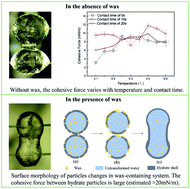Evolution of morphology and cohesive force of hydrate particles in the presence/absence of wax†
Abstract
In the exploitation of deep-sea oil and gas resources, the multiphase production and transportation process is frequently plagued by pipeline blockage issues. Especially when hydrates and wax coexist simultaneously, the viscosity and plugging tendency of multiphase flow systems will synergistically increase. Understanding the evolution of morphology of hydrate particles and the agglomeration characteristics of hydrate particles in the presence or absence of wax crystals is crucial to flow assurance industry. With the assistance of a visualized reactor equipped with a three axis moving platform, microscopic images of cyclopentane hydrate during hydrate growth were obtained, and the cohesive force between hydrate particles was measured. It was found that during the hydrate growth on wax-free water droplets, the untransformed water inside the particles gradually wetted the surface of the particle. With the increase in temperature and contact time, the shell of hydrate particles changed from solid and rough to smooth and moist. The cohesive force measured in this work ranges from 3.14 ± 0.52 to 11.77 ± 0.68 mN m−1 with different contact times and temperature. When the contact time was 0 s and 10 s, the cohesive force between particles increased first and then stabilized with temperature. When the contact time was 20 s, the cohesive force was greater than the first two cases and showed an overall stable trend. An interesting phenomenon was also discerned: a large water bridge between particles formed during their separation process. For the wax-containing system, it required a longer time for water droplets to be converted into hydrate particles than that for wax-free systems. After wax participated in hydrate growth, hydrate particles showed the properties of elasticity and stickiness, which resulted in a larger liquid bridge between hydrate particles after their contact. It was suggested that wax crystal would alter the shell structure of hydrate particles, and change the surface properties of hydrate particles and the formation process of the liquid bridge, leading to significant and rapid increase in the cohesive force.



 Please wait while we load your content...
Please wait while we load your content...